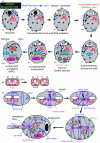Cell evolution and Earth history: stasis and revolution
- PMID: 16754610
- PMCID: PMC1578732
- DOI: 10.1098/rstb.2006.1842
Cell evolution and Earth history: stasis and revolution
Abstract
This synthesis has three main parts. The first discusses the overall tree of life and nature of the last common ancestor (cenancestor). I emphasize key steps in cellular evolution important for ordering and timing the major evolutionary innovations in the history of the biosphere, explaining especially the origins of the eukaryote cell and of bacterial flagella and cell envelope novelties. Second, I map the tree onto the fossil record and discuss dates of key events and their biogeochemical impact. Finally, I present a broad synthesis, discussing evidence for a three-phase history of life. The first phase began perhaps ca 3.5 Gyr ago, when the origin of cells and anoxic photosynthesis generated the arguably most primitive prokaryote phylum, Chlorobacteria (= Chloroflexi), the first negibacteria with cells bounded by two acyl ester phospholipid membranes. After this 'chlorobacterial age' of benthic anaerobic evolution protected from UV radiation by mineral grains, two momentous quantum evolutionary episodes of cellular innovation and microbial radiation dramatically transformed the Earth's surface: the glycobacterial revolution initiated an oxygenic 'age of cyanobacteria' and, as the ozone layer grew, the rise of plankton; immensely later, probably as recently as ca 0.9 Gyr ago, the neomuran revolution ushered in the 'age of eukaryotes', Archaebacteria (arguably the youngest bacterial phylum), and morphological complexity. Diversification of glycobacteria ca 2.8 Gyr ago, predominantly inhabiting stratified benthic mats, I suggest caused serial depletion of 13C by ribulose 1,5-bis-phosphate caboxylase/oxygenase (Rubisco) to yield ultralight late Archaean organic carbon formerly attributed to methanogenesis plus methanotrophy. The late origin of archaebacterial methanogenesis ca 720 Myr ago perhaps triggered snowball Earth episodes by slight global warming increasing weathering and reducing CO2 levels, to yield runaway cooling; the origin of anaerobic methane oxidation ca 570 Myr ago reduced methane flux at source, stabilizing Phanerozoic climates. I argue that the major cellular innovations exhibit a pattern of quantum evolution followed by very rapid radiation and then substantial stasis, as described by Simpson. They yielded organisms that are a mosaic of extremely conservative and radically novel features, as characterized by De Beer's phrase 'mosaic evolution'. Evolution is not evenly paced and there are no real molecular clocks.
Figures









References
-
- Acaso C, Wierzchos J, Speranza M, Gutiérrez J.C, González A.M, de Los Ríos A, Alonso J. Fossil protists and fungi in amber and rock substrates. Micropalaeontology. 2005;51:59–62. 10.2113/51.1.59 - DOI
-
- Alexopoulos C.J. Wiley; New York, NY: 1952. Introductory mycology.
-
- Anbar A.D, Knoll A.H. Proterozoic ocean chemistry and evolution: a bioinorganic bridge? Science. 2002;297:1137–1142. 10.1126/science.1069651 - DOI - PubMed
-
- Armstrong H.A, Brasier M.D. 2nd edn. Blackwell Scientific Publications; Oxford, UK: 2005. Microfossils; p. 296.
-
- Balch W.E, Magrum L.J, Fox G.E, Wolfe R.S, Woese C.R. An ancient divergence among the bacteria. J. Mol. Evol. 1977;9:305–311. 10.1007/BF01796092 - DOI - PubMed
Publication types
MeSH terms
LinkOut - more resources
Full Text Sources
Miscellaneous
